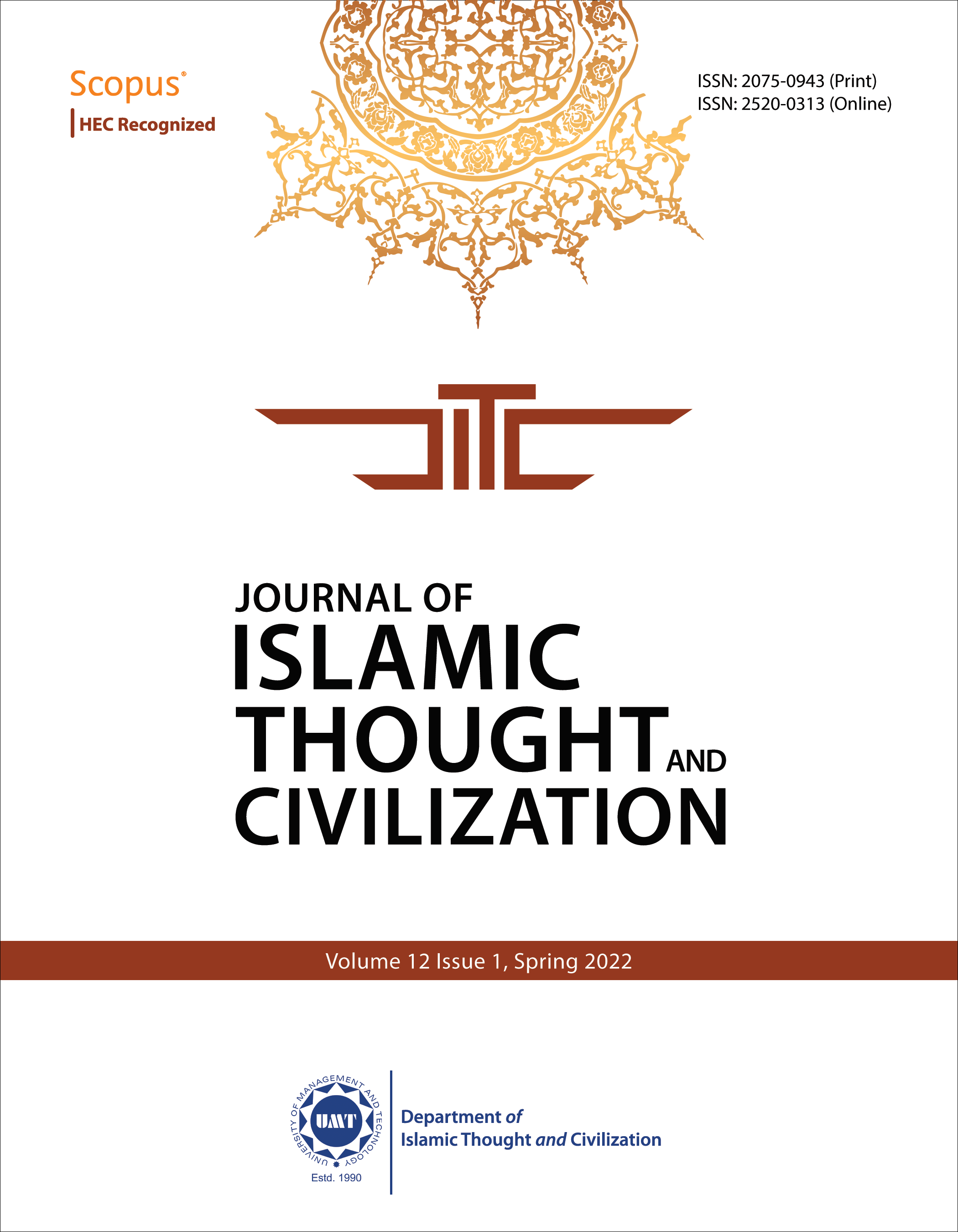The Spiritual Aesthetics of Islamic Ornamentation and the Aesthetic Value in Islamic Architecture
Abstract
 Abstract Views: 511
Abstract Views: 511
Islamic architecture, a form of Islamic art, contributes significantly to portraying God Almighty's supremacy. In Islamic art, there are numerous ways to place emphasis on this architecture; one of which is through high aesthetic value. In Islamic art and architecture, the greatest extent of ornamentation and motifs probably describe aesthetic values. Islamic ornamentation serves as a platform for delivering information about Islam's culture including Islamic values and identity. Additionally, the most distinguishing characteristic of Islamic ornamentation is the richness of meaning behind it, that might influence a person's perception of spiritual aesthetics. Therefore, this article explore what spiritual aesthetic means and how it relates to Islamic ornamentation. Furthermore, Islamic ornamentation should be considered a part of the interior of the Islamic architecture rather than just decorations added after the fact or to cover in gaps. Through the interplay of the people and interior space, these ornaments have the potential to engage with human aesthetics. Therefore, this research also focuses on the aesthetics and beauty of ornaments, which satisfy one of human psychological needs: to be in a beautiful environment. Because emphasis of the research is to explore how people perceive the aesthetics of Islamic ornamentation, a semiotics method was chosen because of its capacity to transcend literal meanings. The identification and evaluation of the aesthetic and religious qualities of the Islamic ornamentation brought out in this paper can be very helpful for the artists as well as scholars in understanding the Islamic art.
Keywords: Islamic Ornaments, Islamic Architecture, Aesthetic Value, Spiritual Aesthetics, Islamic Art, Architectural Ornaments
Downloads
References
Baer, Eva. Islamic Ornament, 1998. https://www.oeaw.ac.at/resources/Record/990001205590504498.
Brend, Barbara., Islamic Art, New York, Cambridge: Hardvard University Press, 1991.
Clevenot, Dominique., and Gerard Degeorge, Ornament and Decoration in Islamic Architecture. London:Thames & Hundson, 2000.
Cobley, Paul. “The Routledge Companion to Semiotics.” Choice Reviews Online Vol. 47, no. 06 (2010): 47-2994-47–2994. https://doi.org/10.5860/choice.47-2994. DOI: https://doi.org/10.5860/CHOICE.47-2994
Cooper, E. David., “A Companion to Aesthetics by Cooper, E. David. and Robert Hopkins (eds).” Choice Reviews Online Vol. 47, no. 04 (2009): 47-1920-47–1920. https://doi.org/10.5860/choice.47-1920. DOI: https://doi.org/10.5860/CHOICE.47-1920
Echtner, Charlotte M. “The Semiotic Paradigm: Implications for Tourism Research.” Tourism Management 20, no. 1 (1999): 47–57. https://doi.org/10.1016/S0261-5177(98)00105-8. DOI: https://doi.org/10.1016/S0261-5177(98)00105-8
Ettinghausen, R. “The ‘Wade Cup’ in the Cleveland Museum of Art, Its Origin and Decorations.” Ars Orientalis 2 (1957): 327–66. https://www.jstor.org/stable/4629041.
Farooqi, Waheed Ali. “Islamic Art and Spirituality.” Idealistic Studies 22, no. 3 (1992): 240–41. https://doi.org/10.5840/idstudies19922231. DOI: https://doi.org/10.5840/idstudies19922231
Faruqi, Lois al. “The Aesthetics of Islamic Art.” The Journal of Aesthetics and Art Criticism 35, no. 3 (1977): 353. https://doi.org/10.2307/430294. DOI: https://doi.org/10.2307/430294
Al-Ghazali, M. “Reflections on Islamic View of Art and Literature.” Islamic Studies 35, no. 4 (1996): 425–34. https://www.jstor.org/stable/20836965.
Gonzalez, V. “Beauty and Islam: Aesthetics in Islamic Art and Architecture.” Choice Reviews Online 39, no. 09 (2002): 39-4975-39–4975. https://doi.org/10.5860/choice.39-4975. DOI: https://doi.org/10.5860/CHOICE.39-4975
Graham, Gordon. "Philosophy of the Arts: An Introduction to Aesthetics", Philosophy, 3rd Edition. London: Routledge Press, 2005. DOI: https://doi.org/10.4324/9780203696224
Grishakova, Marina. “Structuralism and Semiotics.” David H. Richter(ed.), A Companion to Literary Theory, 2018: 48–59. https://doi.org/10.1002/9781118958933.ch4. DOI: https://doi.org/10.1002/9781118958933.ch4
Grube, J. Ernest. The World of Islam: Landmarks of World Art (2nd edition). McGraw-Hill Book Company, (January 1, 1967).
Hillenbrand, Robert. Islamic Architecture: Form,Function and Meaning. New York : Columbia University Press, 1994.
Kant, Immanuel. “Critique of Aesthetic Judgment.” Aesthetics: The Classic Readings, 1997: 94–122,. http://www.self.gutenberg.org/articles/eng/Critique_of_Aesthetic_Judgment.
Kochevar, P, and Ahmed. “A Visualization Architecture for the Sequoia 2000 Project.” S2k-Ftp.Cs.Berkeley.Edu, 1993. http://s2k-ftp.cs.berkeley.edu/sequoia/tioga/vis-architecture.ps.Z.
Leaman, O. “Islamic Aesthetics: An Introduction,” 2004. https://philpapers.org/rec/LEAIAA. DOI: https://doi.org/10.1515/9781474470179
Lumbard, Joseph E. B. Aḥmad Al-Ghazālī, Remembrance, and the Metaphysics of Love, 2016. https://books.google.com/books?hl=en&lr=&id=S7ZLDQAAQBAJ&oi=fnd&pg=PR7&dq=al+ghazali+on+beauty&ots=2VKnE3Cl8C&sig=IhRtpP3TKzq9WlEnxc-M4lL4Noc.
Mick, David Glen, and Laura Ruth Oswald. “The Semiotic Paradigm on Meaning in the Marketplace.” In Handbook of Qualitative Research Methods in Marketing, 31–45, 2006. https://doi.org/10.4337/9781847204127.00009. DOI: https://doi.org/10.4337/9781847204127.00009
N., E., Charles Hartshorne, and Paul Weiss. “Collected Papers of Charles Sanders Peirce.” The Journal of Philosophy 31, no. 7 (1934): 188. https://doi.org/10.2307/2016224. DOI: https://doi.org/10.2307/2016224
Papadopoulo, Alexandre. “Islam and Muslim Art,” 1979, 631. https://ixtheo.de/Record/1107879221.
Schimmel, Annemarie, Titus Burckhardt, and William Stoddart. “Mirror of the Intellect: Essays on Traditional Science and Sacred Art.” Journal of the American Oriental Society 109, no. 3 (1989): 455. https://doi.org/10.2307/604159. DOI: https://doi.org/10.2307/604159
Shafiq, Jeanan. “Architectural Elements in Islamic Ornamentation: New Vision in Contemporary Islamic Art.” Art and Design Studies 21, no. July (2014): 11–21. https://www.academia.edu/download/35250114/Architectural_Elements_in_Islamic_Ornamentat.pdf.
Soroush, Abdolkarim, and John Keane. “The Beauty of Justice.” CSD Bulletin, University of Westminster 14, no. 1 & 2 (2007): 8–12. http://www.drsoroush.com/PDF/TheBeautyOfJustice.pdf.
Stierlin. “Stierlin, H. (2002) Islamic Art and Architecture:... - Google Scholar,” 2002. https://scholar.google.com/scholar?hl=en&as_sdt=0%2C5&q=Stierlin%2C+H.+%282002%29+Islamic+Art+and+Architecture%3A+From+Isfahan+to+the+Taj+Mahal.+New+York%2C+London%3A+Thames+and+Hudson+Ltd.&btnG=.
Waardenburg, Jacques. Islam studied as a symbol and signification system. De Gruyter Mouton, 2020.
Copyright (c) 2022 Fatima Zahra, Safrizal Bin Shahir

This work is licensed under a Creative Commons Attribution 4.0 International License.

This work is licensed under a Creative Commons Attribution 4.0 International License. Authors retain copyright and grant the journal right of first publication with the work simultaneously licensed under a Creative Commons Attribution (CC-BY) 4.0 License that allows others to share the work with an acknowledgement of the work’s authorship and initial publication in this journal.








